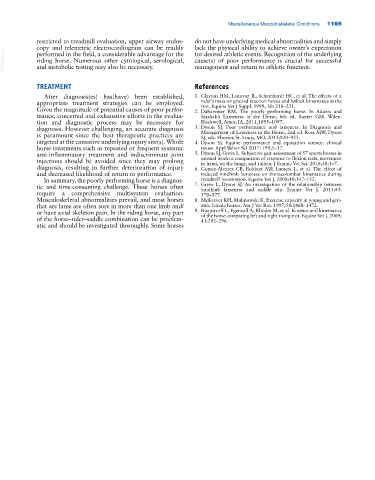Page 1199 - Adams and Stashak's Lameness in Horses, 7th Edition
P. 1199
Miscellaneous Musculoskeletal Conditions 1165
restricted to treadmill evaluation, upper airway endos do not have underlying medical abnormalities and simply
copy and telemetric electrocardiogram can be readily lack the physical ability to achieve owner’s expectation
VetBooks.ir riding horse. Numerous other cytological, serological, cause(s) of poor performance is crucial for successful
for desired athletic events. Recognition of the underlying
performed in the field, a considerable advantage for the
management and return to athletic function.
and metabolic testing may also be necessary.
TREATMENT References
After diagnosis(es) has(have) been established, 1. Clayton HM, Lanovaz JL, Schamhardt HC, et al. The effects of a
appropriate treatment strategies can be employed. rider’s mass on ground reaction forces and fetlock kinematics at the
trot. Equine Vet J Suppl. 1999; 30: 218–221.
Given the magnitude of potential causes of poor perfor 2. Dabareiner RM. The poorly performing horse. In Adams and
mance, concerted and exhaustive efforts in the evalua Stashak’s Lameness in the Horse, 6th ed. Baxter GM. Wiley‐
tion and diagnostic process may be necessary for Blackwell, Ames, IA, 2011;1095–1097.
diagnosis. However challenging, an accurate diagnosis 3. Dyson SJ. Poor performance and lameness. In Diagnosis and
is paramount since the best therapeutic practices are Management of Lameness in the Horse, 2nd ed. Ross MW, Dyson
SJ, eds. Elsevier, St. Louis, MO, 2011;920–925.
targeted at the causative underlying injury site(s). Whole 4. Dyson SJ. Equine performance and equitation science: clinical
horse treatments such as repeated or frequent systemic issues. Appl Behav Sci 2017: 190;5–17.
anti‐inflammatory treatment and indiscriminate joint 5. Dyson SJ, Greve L. Subjective gait assessment of 57 sports horses in
injections should be avoided since they may prolong normal work: a comparison of response to flexion tests, movement
in hand, on the lunge, and ridden. J Equine Vet Sci. 2016;38:1–7.
diagnosis, resulting in further deterioration of injury 6. Gomez‐Alvarez CB, Bobbert MF, Lamers L, et al. The effect of
and decreased likelihood of return to performance. induced hindlimb lameness on thoracolumbar kinematics during
In summary, the poorly performing horse is a diagnos treadmill locomotion. Equine Vet J. 2008;40:147–152.
tic and time‐consuming challenge. These horses often 7. Greve L, Dyson SJ. An investigation of the relationship between
hindlimb lameness and saddle slip. Equine Vet J. 2013;45:
require a comprehensive multisystem evaluation. 570–577.
Musculoskeletal abnormalities prevail, and most horses 8. McKeever KH, Malinowski K. Exercise capacity in young and geri
that are lame are often sore in more than one limb and/ atric female horses. Am J Vet Res. 1997;58:1468–1472.
or have axial skeleton pain. In the riding horse, any part 9. Roepstorff L, Egenvall A, Rhodin M, et al. Kinetics and kinematics
of the horse–rider–saddle combination can be problem of the horse comparing left and right rising trot. Equine Vet J. 2009;
41:292–296.
atic and should be investigated thoroughly. Some horses

